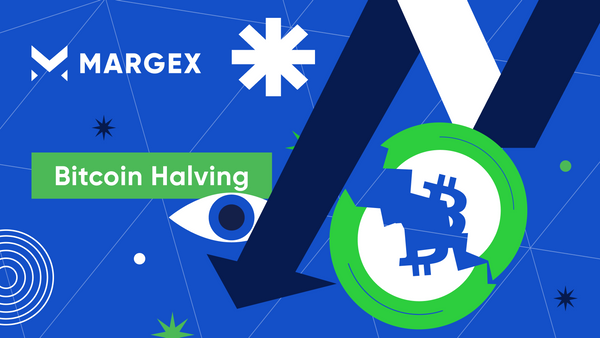Certainly, Bitcoin halvings have been significant milestones in its history, typically followed by bull cycles and new highs. However, this time is different. The approval of Bitcoin ETFs in the U.S. has attracted institutional investors, changing market dynamics and fueling expectations of a bullish "super cycle" for Bitcoin and other cryptocurrencies in 2024 and possibly 2025.
Although the Bitcoin price has fallen more than 5% in the last 24 hours, along with other markets, due to the escalating conflict in the Middle East, this does not undermine the medium to long-term bullish outlook. Corrections are normal and can be healthy in a bull market.
What is Bitcoin Halving?
Bitcoin halving is a scheduled event that occurs approximately every four years, during which the reward miners receive for validating transactions and securing the Bitcoin network is halved. Initially, the reward was 50 bitcoins per block mined, but that amount is halved with each halving. Halving the price of Bitcoin controls Bitcoin inflation and regulates the supply of cryptocurrency, causing the supply of new Bitcoins to become more limited over time. This can influence Bitcoin's value and market dynamics, as reduced supply can lead to price increases if demand remains high.
Historical Analysis
In 2012, Bitcoin experienced its first halving on November 28. Initially, this event did not generate a noticeable change in the cryptocurrency price. However, in early 2013, Bitcoin's value gradually increased, peaking above USD 1,100 in the last quarter of the year. This was followed by a correction in April and a prolonged fall that took the price to USD 152 in January 2015. However, in October 2015, approximately nine months before the next halving, Bitcoin began to experience a steady rise in value.
Bitcoin's second halving occurred on July 9, 2016. This time, the crypto community anticipated the event. It was accompanied by a significant increase in the Bitcoin price, which began about a month and a half before the halving. Although there was a correction after the halving, the uptrend quickly resumed and peaked in December 2017, with a peak price of USD 19,700.
The 2020 halving, which took place on May 11, did not cause an immediate increase in the price of Bitcoin. However, growth had begun earlier in the year, although the coronavirus crisis in March caused a drop in the cryptocurrency price. Assessing the impact of halving on the price is further complicated by the small number of Bitcoins mined compared to those traded, suggesting that future price growth will be more influenced by demand than supply.
Countdown! Bitcoin Halving 2024
The next Bitcoin halving is expected this year when the reward per mined block will be reduced to 3.125 BTC. With the date of the next Bitcoin (BTC) halving set between April 19 and April 21, 2024, traders are enthralled by the anticipation of this event. This highly anticipated event has generated remarkable optimism among investors, and according to several industry experts, it looms as a "one-of-a-kind" occasion due to several factors.

Important Aspects
Inflation
Bitcoin is halved to curb potential inflation within the Bitcoin system. This is because when the production of new Bitcoins is reduced and block rewards are decreased, the price stability and long-term value of the Bitcoin are more likely to be preserved, which helps control price inflation.
Scarcity and controlled supply
Bitcoin was created to be a rare and limited cryptocurrency. As a result, when a Bitcoin is halved, its availability becomes rarer, which can affect its value and supply.
Trading Implications
While the Bitcoin halving event garners significant attention from miners, its implications extend far beyond mining operations—it's also a critical consideration for traders. This event profoundly impacts the broader Bitcoin ecosystem and can significantly influence price dynamics.
Investors need to grasp the ramifications of this reduction in new supply and how it can affect their strategies, especially concerning long-term holdings. Understanding the potential effects of reduced Bitcoin issuance on supply and demand dynamics is crucial for informed decision-making in the cryptocurrency market.
Moreover, the halving of Bitcoin often triggers increased market volatility as investors reassess the cryptocurrency's value proposition in light of changing supply dynamics. As such, traders should carefully evaluate their risk tolerance and investment objectives to navigate these fluctuations effectively.
Additionally, the halving event underscores Bitcoin's role as a deflationary asset, contrasting sharply with traditional fiat currencies subject to inflationary pressures. This characteristic may appeal to investors seeking to hedge against inflation and preserve purchasing power over the long term.

Understanding Bitcoin Halving
Bitcoin halving fundamentally alters the rate at which new Bitcoins are generated, cutting it in half. This mechanism is designed to ensure that the total supply of Bitcoin does not exceed 21 million, thereby establishing Bitcoin as a deflationary asset. The event significantly impacts Bitcoin mining, reducing the rewards miners receive for validating transactions on the network.
This reduction in mining rewards leads to a constrained issuance of new Bitcoins, thereby enhancing scarcity. Unlike traditional fiat currencies, which central authorities can endlessly print, Bitcoin operates within a predetermined supply schedule. Bitcoin proponents have long championed this characteristic, as it reinforces the cryptocurrency's store of a value proposition.
The diminishing rewards for miners affect the supply dynamics and serve as a fundamental driver of Bitcoin's value. As the issuance rate decreases, Bitcoin's scarcity intensifies, potentially increasing its price. However, it's crucial to recognize that miners remain integral to the Bitcoin network despite the reduction in mining incentives. They continue to validate transactions, secure the network, and ensure its operational integrity.
Bitcoin halving represents a pivotal event in the cryptocurrency's ecosystem, shaping its supply dynamics and influencing its long-term value proposition.
Conclusion
In conclusion, the Bitcoin halving is a pivotal and transformative event within the cryptocurrency realm. By altering supply dynamics, it has the potential to impact the value of Bitcoin significantly and, consequently, the broader digital asset market. Understanding the implications of the Bitcoin halving is imperative for both seasoned crypto traders and newcomers alike, as it shapes the evolving landscape of digital assets.
Furthermore, staying informed about Bitcoin's halving events is crucial for understanding its price dynamics and gaining insights into the behavior of other cryptocurrencies, often referred to as altcoins. The halving underscores Bitcoin's unique characteristics, positioning it as a disruptive force in finance and solidifying its status as a store of value for the digital age.
Whether considering Bitcoin as a long-term exploring trading opportunities, comprehensive research and an understanding of market dynamics are the key.


